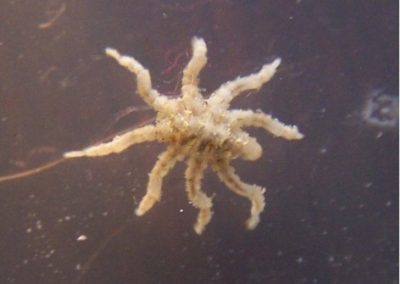Zoanthids are beloved for their color, hardiness, and fast growth—but they also attract some of the weirdest pests in reefkeeping. One of the most unsettling is the Zoanthid-Eating Spider: a tiny, marine arthropod that preys on Zoas and often goes undetected until damage becomes visible.
What Are Zoanthid-Eating Spiders?
These pests are not true spiders, but small crustaceans with long legs and a body shape that resembles terrestrial spiders. They’re typically 1–3 mm in size, pale to translucent, and extremely hard to spot with the naked eye unless you’re looking closely under magnification.
They live among or under Zoanthid polyps, where they:
- Feed on Zoa tissue and mucus
- Cause polyp retraction and tissue melting
- Lay eggs nearby (small white dots)
Spiders often appear in pairs or small groups and can reproduce in a reef system if not removed.
Signs of Infestation:
- Zoanthids stay closed for days
- Polyps melting or disappearing without obvious signs of disease
- No visible nudibranchs or flatworms
- Tiny spider-like creatures visible under magnification, often on stalks or between polyps
How Do They Spread?
Zoanthid-Eating Spiders are typically introduced on new Zoa frags or colonies. They can live unnoticed in crevices or under polyps during shipping and fragging, especially if corals are not dipped.
Treatment Options:
1. Dipping
A strong coral dip is the first line of defense. Use Coral RX, Revive, or iodine-based dips.
- Dip for 10–15 minutes following product instructions
- Use a turkey baster to flush polyps thoroughly
- Inspect closely after dipping and remove any visible spiders manually
2. Manual Removal
- Use tweezers under magnification to pluck spiders from stalks or rock crevices
- Rinse the coral in clean saltwater to remove debris and remaining pests
3. Quarantine and Repeat Dips
Quarantine affected frags and repeat dips every few days until no more spiders appear. Look closely for egg sacs or new juveniles.
Prevention Tips:
- Always dip new Zoanthid frags thoroughly
- Inspect under magnification when possible
- Avoid introducing live rock or plug bases from unknown systems
- Quarantine Zoas for at least a week before moving to the display
Final Thoughts:
Zoanthid-Eating Spiders are rare but destructive. They’re also among the creepiest pests you’ll encounter in reefkeeping. Stay vigilant when adding Zoas to your tank, and don’t skip dips—even if the frag looks clean. Your Zoa garden depends on it.
